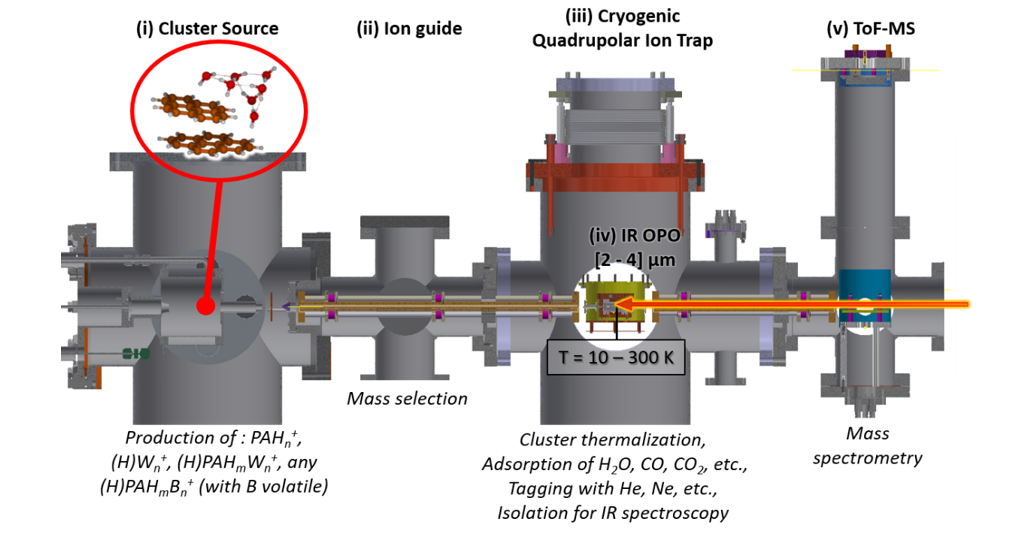INFRARED SPECTROSCOPY OF CARBONACEOUS NANOGRAINS FOR ASTROCHEMISTRY
NANOSCIENCE

Lab: LCAR
Duration: NanoX master Internship (8 months part-time in-lab immersion
Latest starting date: 15/09/2025
Localisation: Laboratoire Collisions Agrégats Réactivité
University of Toulouse - Bat. 3R4 - 118 route de Narbonne - 31062 Toulouse Cedex 09 - France
Supervisors:
Alexandre MARCINIAK alexandre.marciniak@irsamc.ups-tlse.fr
Sébastien ZAMITH sebastien.zamith@irsamc.ups-tlse.fr
This research master's degree project could be followed by a PhD
Work package:
In the interstellar medium (ISM), cosmic grains are crucial for its chemistry. Indeed, these catalytic platforms interacts with molecules of the gas phase and produces new species which chemically enrich star and planet forming regions. In some regions of the ISM, it exists an abundant population of grains which have a (sub-)nanometer size, also called nanograins. Since they have a huge surface over volume ratio, nanograins are at play in the physical and chemical evolution of these regions. Microscopically, they correspond to atomic or molecular clusters down to single molecules of polycyclic aromatic hydrocarbon (PAH) [1]. The nanograin morphology especially drives the fundamental interactions (adsorption, desorption, molecular diffusion) between them and small molecules of the gas phase (e.g. H2O, CO, etc.). Therefore, the understanding of nanograin structures is a crucial step which remains very little explored up to now [2].
The CASSOULExp setup (see Figure 1) has been developed in the framework of an ANR project [3] which aims to study gas-nanograin-photon interaction in astrophysical conditions. This setup is equipped with a molecular cluster source to produce the nanograins and a cryogenic ion trap to store them in extreme isolation conditions (~6 K, ~10-9 mbar). The aim of this internship is to couple this setup to a tunable IR laser source (IR OPO) and to perform the first IR spectra on mixed PAH-water clusters. The setup will then be used to systematically characterize the structures of cationic carbonaceous nanograins (e.g. PAHn+ or [PAHn(H2O)m]+, [4]). The student will participate to this development and perform measurements of IR action spectra of some simple clusters to validate the methodology. Depending on the student involvement and interest, she/he will also perform more measurements on more complex nanograins and study the modification of these spectra as a function of the nanograin composition. Moreover, these results will be compared to quantum chemistry calculations, performed by our collaborators at LCPQ, in order to evaluate the nanograin structures [5]. These new data will notably help to interpret astrophysical observations which are currently performed by the James Webb Space Telescope [6].

References:
[1] Pilleri, P. et al. A&A 542, A69 (2012).
[2] Chatterjee, K. et al. Chem. Sci. 9, 2301 (2018).
[3] Marciniak, A. et al. hal-03752080, https://hal.archives-ouvertes.fr/hal-03752080.
[4] Zamith, S. et al. J. Phys. Chem. A 126, 3696-3707 (2022).
[5] Dontot, L. et al. J. Phys. Chem. A 123, 9531-9543 (2019).
[6] Berné, O. et al. PASP 134 (1035), 054301 (2022).
Areas of expertise:
molecular physics, spectroscopy, cluster physics, mass spectrometry, optics, astrochemistry,
Required skills for the internship:
Required skills Good educational background in physics (quantum physics, molecular physics, electromagnetism, optics, electronics) and strong interest and skils in experimental physics and data analysis. Knowledge in (astro-)chemistry are a not mandatory but will be appreciated.
